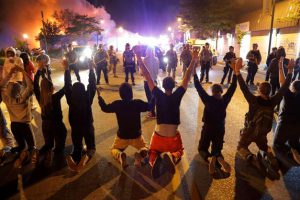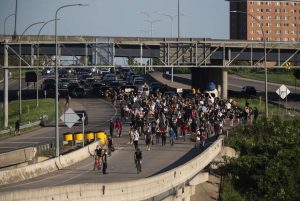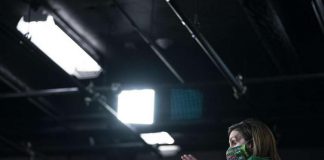MAY 30, 2020

(Pictured) Demonstrators kneel before police on May 30 in Minneapolis.
Chaos spread across the country Friday night into Saturday morning as thousands of protesters descended on city streets, demanding justice in the wake of 46-year-old George Floyd’s killing in Minneapolis earlier this week.
Several demonstrations escalated into violence as police cars were burned and scuffles broke out between law enforcement and protesters.
Banks, gas stations, and even a post office were destroyed in Minneapolis where the unrest began earlier this week. A 19-year-old man was killed in Detroit.
Minnesota Gov. Tim Walz pleaded with protestors and looters to return home and stop the destruction of businesses. He called the situation on the ground “incredibly dangerous” and “incredibly dynamic,” prompting the mobilization of more than 2,500 law enforcement officers from multiple agencies, including the National Guard.
Walz, at a news conference early Saturday, said maintaining control of the Twin Cities was starting to look more like a military operation than a peacekeeping mission.”This is not about George’s death.
This is not about inequalities that were real. This is about chaos,” he said.
Walz also acknowledged reports that white supremacists and drugs cartels were taking advantage of the widespread chaos in Minneapolis and fueling some of the destruction throughout the region. The governor said his office was working closely with federal officials to identify any organized groups fueling the mayhem.
Walz activated the National Guard early Friday to help with response efforts. He also issued a curfew that went into effect Friday at 8 p.m., but protesters ignored the directive. Instead, thousands of people fanned out through Minneapolis leaving ash in their wake.

(Pictured) A man reacts as National Guard members guard the area, in Minneapolis, Minnesota, on May 29.
In a show of force rarely seen on American streets, dozens of armed law enforcement officers marched in formation toward the Minneapolis Police Department 5th precinct Friday night, one day after demonstrators destroyed the 3rd precinct, the former home base of four officers connected to Floyd’s death.
New York City Mayor Bill de Blasio warned of a “long night ahead” Friday after a police department van was engulfed in flames. Los Angeles police vehicles were also vandalized in Southern California.
In Atlanta, a tense scene grew fiery as hundreds of people stormed the CNN building hours after reporter Omar Jimenez was arrested while on live TV in Minneapolis. Police used tear gas on protesters in an attempt to quell some of the fervor that had overtaken parts of the city. In the nation’s capital, a rally prompted a brief lockdown at the White House.
It was later lifted but demonstrations grew increasingly tumultuous throughout the night. Earlier in the day, Minnesota’s governor pleaded for peace after “48 hours of anarchy” but none could be found. “It’s time to rebuild our community and that starts with safety in our streets,” Walz said in a statement.
“Thousands of Minnesotans have expressed their grief and frustration in a peaceful manner. But the unlawful and dangerous actions of others, under the cover of darkness, has caused irreversible pain and damage to our community.” President Donald Trump responded to the unrest on Thursday by calling rioters “thugs” and threatening that “when the looting starts, the shooting starts.”
Almost immediately, Twitter placed a warning on the post, saying it glorified violence. Trump softened his tone Friday, saying the White House is speaking with Floyd’s family and working closely with law enforcement. “I understand the hurt. I understand the pain. People have really been through a lot,” he said. “The family of George is entitled to justice, and the people of Minnesota are entitled to live in safety. Law and order will prevail. The Americans will honor the memory of George and the Floyd family.”
Meanwhile, Walz, a Democrat, promised to end “48 hours of anarchy” that led to smashed windows, destroyed property, and the looting of several stores in Minneapolis.
Walz also questioned why city officials did not engage with protesters and arsonists who set fire to the 3rd precinct station. Ex-police officer Derek Chauvin was fired Tuesday along with the three other officers involved in Floyd’s death. Chauvin was taken into custody Friday and faces third-degree murder and manslaughter charges, according to Hennepin County Attorney Mike Freeman.
A request to Chauvin’s lawyer for comment was not immediately returned Friday night. Minneapolis police identified the other officers as Thomas Lane, Tou Thao and J. Alexander Kueng. The other officers have not been charged, but the investigation remains ongoing, Freeman said.
Video footage released earlier in the week shows Chauvin, who is white, putting his knee on Floyd’s neck for more than 8 1/2 minutes as he cried “I can’t breathe” and called out for his mother. Stunned onlookers watched helplessly as Floyd, who was black and a former high school star athlete, gasped for air.
The fatal encounter took place Monday after a grocery store clerk called the police and reported that Floyd had tried to pay with a counterfeit $20 bill.
Floyd’s loved ones described him as a “gentle giant” who coached kids in his spare time. But his legacy, at least in the immediate, will be of the man whose death forever changed the Twin Cities. “This is a young rage, the same way young people took to the streets in the 1960s, 70s and 80s,” Saje Mathieu, a history professor at the University of Minnesota who lives in suburban Minneapolis, told NBC News.
“They’re saying, ‘We’re already cut. We’re already hurt. We’re already bruised. There’s no other way to communicate my pain and rage than to take to the streets.”
Protests broke out all across the country in the wake of Floyd’s death. From New York, where demonstrators blocked the Brooklyn Bridge on Friday, to Los Angeles where a protester smashed through a police cruiser with his skateboard Wednesday, the days and nights following Floyd’s killing were filled with anger, frustration and a demand for justice.

Image: Protests Continue Over Death Of George Floyd, Killed In Police Custody In Minneapolis. – Stephen Maturen
Many of the nation’s police departments condemned the tactics used to restrain Floyd, who was seen in video footage pinned facedown while Chauvin appeared to maintain pressure on Floyd’s neck with his knee despite repeated pleas from Floyd that he couldn’t breathe.
When Floyd stopped moving, officer Kueng “checked Mr. Floyd’s right wrist for a pulse and said, ‘I couldn’t find one.’ None of the officers moved from their positions,” according to the criminal complaint.
The medical examiner found no evidence that Floyd died from traumatic asphyxia or strangulation. Instead, Floyd had coronary artery and hypertensive heart disease and, “the combined effects of Mr. Floyd being restrained by the police, his underlying health conditions and any potential intoxicants in his system likely contributed to his death,” the complaint said.
“The police officer and those who were there that day failed George Floyd,” said Chuck Wexler, executive director of the Police Executive Research Forum. On Friday, former President Barack Obama said Floyd’s death “shouldn’t be normal in 2020.”
“If we want our children to grow up in a nation that lives up to its highest ideals, we can and must be better,” he said.
Courtesy/Source: NBC News










































































































